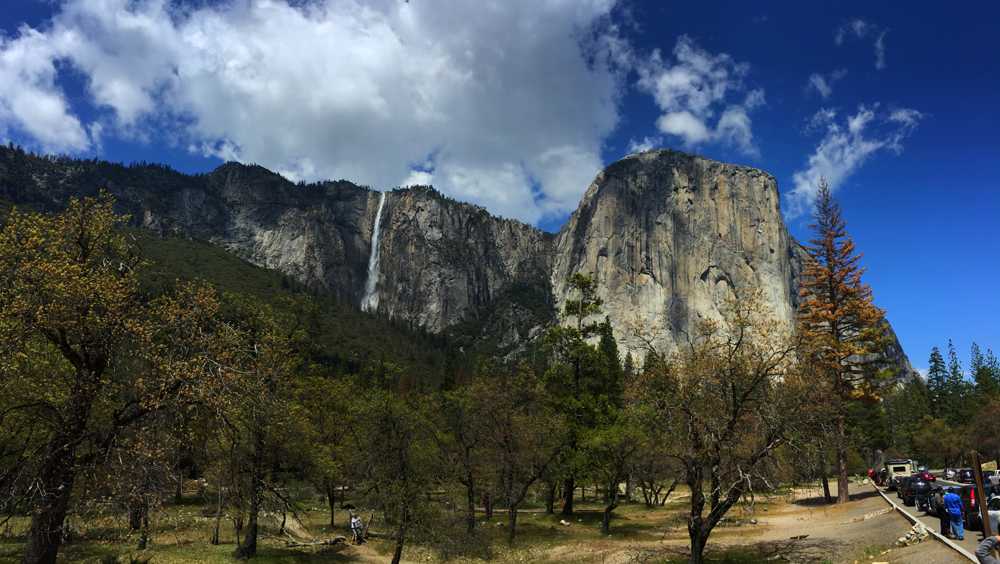On Thursday, September 11, at approximately 10:30 am, the Yosemite Emergency Communications Center (ECC) received an international call from a woman stating that her husband’s climbing partner had sent her a text from El Capitan requesting a rescue. A 39-year-old male climber fell while climbing pitch 25 of 31 (the Glowering Spot) on the Nose route, which is a 2,900-foot climb (Grade VI, 5.14a or 5.9 C2). The subject, along with his climbing partner, had slept at the base of pitch 25 on their second night on the wall. The subject began leading pitch 25 at about 9 am, aid climbing off a ledge above where the two climbers had slept. As the subject climbed, he placed protection gear: one stopper, followed by a second stopper, and then a cam. The cam pulled out and the subject started falling, hitting the ledge about 20 feet below him; as he fell beyond the ledge, the first stopper caught him. Later examination revealed that the second stopper was still in the wall with the quickdraw (a piece of webbing) hanging from it, but the lower carabiner, which had been clipped to the rope, was gone. The climbers do not know whether the carabiner broke or became unclipped during subject’s fall. As a result of the fall and hitting the ledge, the subject had severe lower back pain.
About A Second Remaining El Capitan Virus
Installing OS X 10.11. The climber is the first person to reach the top of Yosemite’s 3,000-foot El Capitan wall without ropes. Jul 21, 2015 Hey guys, Motherboard is a Z77E-ITX CPU is a 3570K Video card is 660 TI SSD is Samsung 850 Evo I managed to get to the installation process, formatted a partition and have a journal for my HFS+ partition, and now I'm getting stuck at the last part where it says there is a second remaining. When you download OS X El Capitan using. Restart your Mac and try to re-download. If you still have a problem, delete the partially downloaded file, THEN restart and try downloading again. With the public launch of OS X El Capitan right around the corner, the reviews are now coming in.
The climbing partner lowered the subject to a ledge, escaped the belay and began giving care to the subject. The climbing partner unsuccessfully attempted to yell for help and call 911; he then texted the subject’s wife in Spain. The subject’s wife called the Yosemite ECC and alerted the park to the accident. The climbing partner called 911 again but had difficulty communicating due to the language barrier. Rangers went to the El Capitan Meadow and set up a spotting scope and megaphone; around noon they located the climbing partner on the wall of El Capitan and began communicating with him by loudspeaker, confirming that the climbing party needed help.
 A team of 13 Yosemite search and rescue (YOSAR) members was assembled and flown by helicopter, along with their gear, from El Capitan Meadow to the top of El Capitan. The YOSAR team began rigging for a high-angle rescue, estimating that the subject was roughly 800 to 1,000 feet below the summit of El Capitan.* The rescue team lowered a ranger-medic to the injured subject, who then packaged the subject into a litter (a metal basket). Due to high winds, the rescue team decided not to lower the ranger and patient to the base of El Capitan, and instead raised them 900 feet to the top. Upon arriving at the summit, care of the patient was transferred to another ranger-medic; he and five other rescue team members carried the subject in the litter uphill about one-half mile to a flat landing zone. The helicopter picked up the ranger-medic and patient and flew them to Yosemite’s Crane Flat Helibase, where an NPS ambulance was waiting to transport the patient out of the park to a regional hospital.
A team of 13 Yosemite search and rescue (YOSAR) members was assembled and flown by helicopter, along with their gear, from El Capitan Meadow to the top of El Capitan. The YOSAR team began rigging for a high-angle rescue, estimating that the subject was roughly 800 to 1,000 feet below the summit of El Capitan.* The rescue team lowered a ranger-medic to the injured subject, who then packaged the subject into a litter (a metal basket). Due to high winds, the rescue team decided not to lower the ranger and patient to the base of El Capitan, and instead raised them 900 feet to the top. Upon arriving at the summit, care of the patient was transferred to another ranger-medic; he and five other rescue team members carried the subject in the litter uphill about one-half mile to a flat landing zone. The helicopter picked up the ranger-medic and patient and flew them to Yosemite’s Crane Flat Helibase, where an NPS ambulance was waiting to transport the patient out of the park to a regional hospital.Meanwhile, with sunset fast approaching, the rest of YOSAR team started a second rescue operation to extract the subject’s climbing partner. A rescuer was lowered down to the climbing partner, and then they both were raised, along with approximately 100 pounds of climbing gear, to the top of El Capitan by the remaining rescue team members. The YOSAR team and climbing partner were flown to Crane Flat Helibase by helicopter with a mere 15 minutes to spare before sunset (the latest time of the day that a helicopter can use a landing zone like the one at the top of El Capitan).
--
* Here is a more detailed description of the rescue:
When YOSAR rigs for a high-angle rescue, both a main line and a belay line are created. This provides for a redundant system, meaning if one of the rope systems were to fail, the other would still be intact. Two 1,200-foot ropes and one 600-foot rope were tied together for the belay line and the same was done for the mainline. Several people were stationed at both the belay and main lines during the lower to help manage the rope.
In addition to the main and belay line, two edge attendants are needed for a high-angle rescue. These people are on a self-belay system at the edge of the high-angle terrain (in this case, the end of the vertical terrain on El Capitan). The edge attendants help the litter attendant with the transition from a horizontal environment to the vertical one.
The litter attendant is the person who goes over the edge of El Capitan to make contact with the injured party. The litter attendant is attached to both the main and belay lines. The attendant is lowered over the edge with the litter (the basket the injured person is put in). The litter attendant is a big wall climber and often a parkmedic or paramedic, who can provide advanced life support.
Once the entire high-angle system was in place, the Yosemite SAR team began to lower the litter. Communicating via radio, the team lowered the litter attendant to the injured party. When the attendant reached the party, he confirmed the lead climber had taken a lead fall and had injured his back.
Due to both the condition of the patient, and the wind conditions of the day, the litter attendant determined the patient would need to be raised to the top of El Capitan and then flown to a waiting ambulance. He communicated this to the litter teams, and they began to rig for a raise. The main and belay teams built a pulley system into the main line, creating a three-to-one mechanical advantage. This meant that for a 1,000-foot raising operation, the main line team would have to pull up 3,000 feet of rope.
Once the teams were rigged for a raise, and the litter attendant was ready, the teams began to haul. At this point, the 13 team members were distributed across the various stations so that only two people were raising the belay line and six people were raising the main line. The team on the main line was pulling most of the weight, which was that of two men and a litter, roughly weighing 350 pounds. In order to pull the attendant and patient to the top, the main line haulers would attach ascenders to the main line, and then pull the rope approximately 50 yards before having to detach the ascenders from the line and then move back uphill to the top of the rope so they could repeat the process.
Because the team had to haul the patient to the top, the patient’s uninjured partner and their gear had to wait for a second raising operation. The team raised the injured party and attendant to the top of El Capitan. Once the party was out of the vertical terrain, a paramedic began to attend to the patient. The rest of the team began to reset the main and belay lines for another lower for the partner and gear.

The paramedic administered pain medication, and then he and five other team members carried the patient to the El Capitan helicopter landing zone, which was approximately one-half mile uphill from where the team was.
Once the team reached the landing zone, the paramedic and another team member stayed with the patient while waiting on the helicopter. The other four team members returned to the rest of the team. Once the helicopter arrived, the paramedic and the patient would fly to the Yosemite helibase and rendezvous with a waiting ambulance.
While the patient was being transported, the rest of the team lowered another litter attendant to the partner. The team then rigged for a raise, creating another three-to-one pulley system for the main line. By the time the four team members returned from carrying the patient to the landing zone, the team was ready to raise. This time the weight of the raise was approximately 400 pounds.
The team was informed that sunset was at 7:43 pm that night. This meant that if they were going to be helicoptered off of the El Capitan summit, they would need to finish their last helicopter run by 7:43 pm. In order to get all of the team and their gear off of the summit, they would need to do three helicopter runs. When the team began their final raising operation, the time was roughly 5:40 pm.
While the final raising operation was being completed, another team member began to build a sling load for the gear. Once the partner and attendant were back in the horizontal environment, the team began to break down the systems as quickly as possible.

